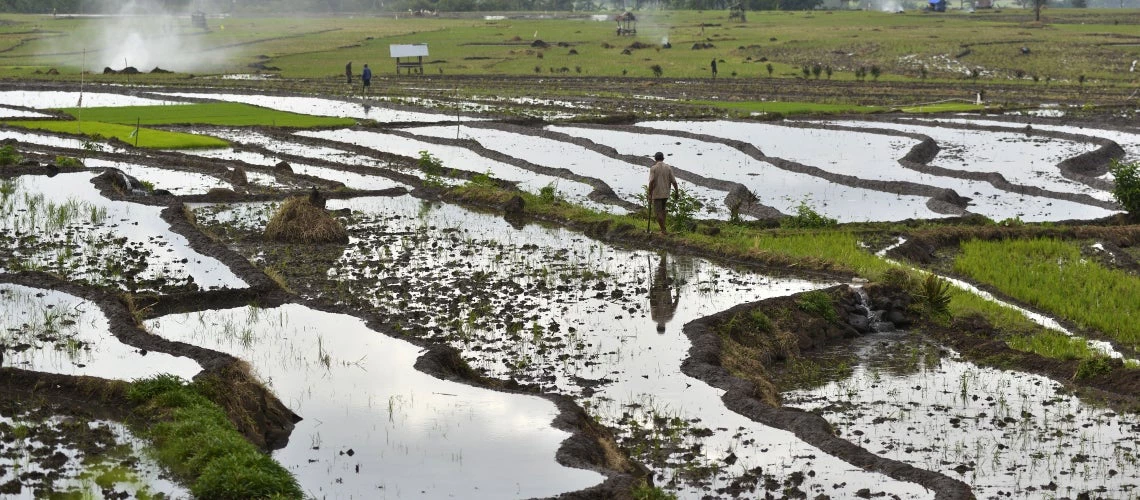 Risks to water security are the greatest threat to attaining global sustainability goals.
Risks to water security are the greatest threat to attaining global sustainability goals.
It is hard to look out the window or read the news without seeing the effects of climate change. Natural disasters are occurring with alarming frequency. Climate change is disrupting global weather patterns, triggering increasingly extreme weather events including floods, droughts, and heatwaves, exacerbating water scarcity and causing catastrophic suffering from Pakistan to the United States to Kenya.
Risks to water security are the greatest threat to attaining global sustainability goals. Global heating of between two to four degrees Celsius could cause up to four billion people to experience some level of water scarcity . Historically, water storage systems have enabled humans to thrive in a range of climatic conditions. But as the climate changes, many water storage systems are becoming—or in some regions have already become—no longer fit for purpose. Exacerbating the water crisis is the fact that the world is already experiencing a widening water storage gap - the difference between the amount of water storage needed and the amount of storage that exists for a given time and place.
Over the last 50 years, while the global population doubled, natural freshwater storage declined by around 27,000 billion cubic meters due to melting glaciers and snowpack , and the destruction of wetlands and floodplains. Concurrently, the volume of water in built storage is threatened as sediment fills storage space in artificial reservoirs, and as maintenance of dams, water tanks, and other man-made structures lags in many regions.
In short, global water storage is decreasing just when water storage is becoming critical to mitigating the effects of climate change. If we are to meet our climate adaptation and mitigation targets, inertia is not an option. To manage escalating hydro-variability, provide for increased water demands due to higher temperatures, and sustain progress in food and energy security, a fundamental change in how we conceptualize and manage water storage is required. How must traditional approaches to water storage planning and management evolve to meet the progressively urgent needs of the twenty-first century?
Nature must be a large part of the solution. More than 99 percent of freshwater storage on earth is in nature, yet it is largely taken for granted. We need to do a better job of recognizing natural storage like groundwater, wetlands, glaciers, and soil moisture reserves as fundamental to survival and protect and manage them accordingly. Knowing what we have is the first step towards not taking nature for granted and unnecessarily depleting it, as has been the case in parts of the world for decades.
The increasing uncertainty brought about by climate change is daunting.
Built storage, on the other hand, helps compensate for changing water availability, mitigating extremes, and providing essential services. These include vital services such as clean drinking water, including bulk water supply for growing cities, flood control, clean energy, transportation, and irrigation. Water stored for food production can help mitigate the effects of droughts, which can negatively affect health and development of the most vulnerable for generations. Firms with reliable water supply show higher performance than those with less reliable supply, especially in the informal sector. And importantly, hydropower reservoirs are a store of clean energy, helping to mitigate climate change.
While communities and economies, large and small, have long relied on natural, built, and hybrid solutions, they have long been developed and managed in silos—and that comes with a price. Competing storage systems serving different stakeholders with different services, often separated by borders or boundaries, leads to uncoordinated development or water releases and a reduction in benefits overall. As natural storage types like groundwater, watersheds and flood plains are often taken for granted, there is a lack of understanding of the services they provide to stakeholders across a range of sectors and locations, leading to overuse and degradation. Some storage investments are proving unequal to the challenge of climate change and need to be altered for safety concerns and performance requirements; to handle increased floods, for example. A diverse storage system which incorporates natural and built storage will be more resilient to weather-related shocks than individual facilities.
Evolving our water storage strategy is not the entire answer to climate change, but a holistic approach that brings together a range of economic sectors and stakeholders, both public and private, and backed by investment, will create a strong foundation for sustainable solutions to adapt to climate change. To get there, people at every level, from policy makers to water managers, need to begin thinking about evaluating, developing, and managing water storage not as independent facilities for a finite number of stakeholders, but as integrated systems that consider the whole spectrum of natural, built, and hybrid storage options to deliver resilient solutions that are designed to protect generations.
Drawing from the World Bank’s decades of global experience with integrated water resource management, What the Future Has in Store: A New Paradigm for Water Storage supports countries as they develop, operate, and fortify water services. The report provides a practical framework for rethinking the design of storage solutions, including tools to help with everything from evaluating long-term investments in natural and built infrastructure, to decision-making under uncertainty, to integrated planning techniques, and international case studies. It provides step-by-step guidance to help stakeholders at every level begin to put a new approach into action.
The increasing uncertainty brought about by climate change is daunting. We must contend with the reality that the past is not necessarily a reliable guide for the future; nevertheless, we must act. But as we look to parts of the world where decades of gain in human development are being erased by extreme water events, sometimes in a matter of days or weeks, it is clear that in the future, the communities and regions that will emerge as most resilient will be those that have made the most of their water storage. As we rise to the challenges of development in the context of climate change, smarter water storage solutions can be the difference between human suffering and securing a future. It is a long journey, but one we cannot afford not to make.


Join the Conversation